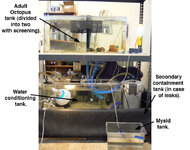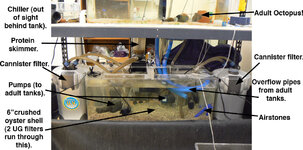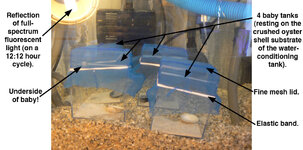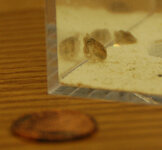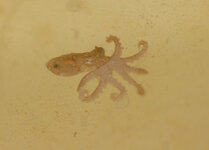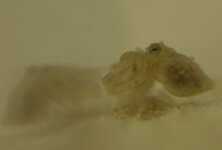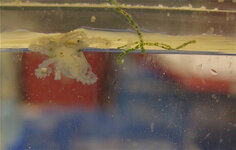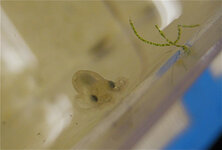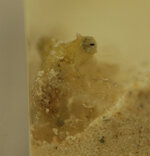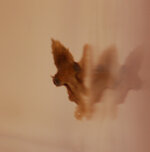- Joined
- Feb 11, 2008
- Messages
- 63
First, I must apologize for not having posted anything sooner. When I first noticed eggs, I was very pessimistic about the odds of their being fertilized and viable, especially since the clutch looked very small (only about 12 eggs that I could see) and I was concerned about the health of the eggs. Then, once the babies started hatching I was just so busy I did not get around to writing any posts (this was not the relaxing Christmas break I was hoping for, but it was worth it!). Anyway, I have written a quick summary below, followed by notes taken from my lab book. If anyone wants more details, please feel free to ask!
I will post some photos tonight.
Cheers,
Lene.
PS I refer to all the babies as “she” although, of course I don’t really know the sex. It’s like ships.
SUMMARY.
My wild-caught O. bimaculoides laid a small clutch (12 eggs) after 6 weeks in captivity. After 8 weeks of brooding by the mother (water temp constant at 72oF/21oC) the first babies hatched. They continued to hatch over the next couple of days. In total I had 10 hatchlings. They were very inactive for the first 5 days or so, but would ink if startled.
The babies did not eat anything for the first 6 days then started to hunt. At first the babies caught and ate the “saltwater amphipods of unknown species” from Paul Sachs Aquaculture (product code samph1). I HIGHLY recommend these little rock-loving shrimp as starter food for babies, as they seem to be much easier for the babies to catch than live mysids. The babies learnt to catch live mysids over the next few days. Concurrent with the development of hunting came adult-like changes in coloration and posture, and after a couple of weeks, flashing eyespots.
Once the babies started to hunt, they also started to fight with each other, so I isolated each baby in an individual tank within the main system. Each baby has a bivalve shell as a den, and currently eats 8-10 live mysids a day (at one month old). I change 25% of the water within the baby tanks daily. They get a full-spectrum fluorescent light for 12 hours; 8am – 8pm.
RUNNING DIARY.
10/20/08 Female doesn’t come out of her den, even when I drop in a crab. She was still very active (and out of her den) on 10/18.
10/22/08 Female is still not leaving her den. The crab coming near is just flicked away. I remove the crab.
10/23/08 It occurs to me that she might be brooding. I carefully look inside the den, and yes, there are eggs in there. I can only see about 12 eggs, but she might be hiding more.
10/24/08 - 12/12/08 the female is still eating as long as I hold a crab at the entrance to her den. After a few minutes, an exploratory arm will come out, and eventually she will take and eat the crab.
12/15/08 I notice the remains of yesterday’s crab uneaten by the mother, although she took and killed it.
12/16/08 I notice three babies on the tank wall! Two are tucked into corners (i.e. surrounded on three sides by wall/substrate). The third is in an edge where two walls meet. After a some excited squealing (not very scientific; sorry) I decide that I try maximizing my odds of a large surviving brood by raising the babies under a variety of conditions, in the hope that one set of conditions will prove successful (at this point I was still hopeful that there were a ton more eggs in the clutch, and I just hadn’t seen them). I talked to a contact at the NRCC for advice, and the main points were;
1. The babies will not eat for a few days as they have some residual yolk sac.
2. The mother might infect the babies with a skin parasite, to which they are susceptible (but to which the mother is immune) so ideally the babies should have a separate water system from the mother.
My system contains two other animals (both wild-caught), and I have no capacity to set up a separate water-conditioning system, so I decide to move one baby into a separate tank (5”x 8” x5”) covered with a piece of muslin secured with an elastic band. For the time being I leave the other two babies in the main tank. The babies are very inactive; the only sign of movement is breathing.
12/17/08 Three more babies! I add two to the separate tank (which gets a 50% water change twice a day), and also set up a second small tank, covered with muslin, that I place within the water-conditioning tank within the main system, in which I place two more babies. There are still two left in the tank with the brooding mother.
I add a few “unknown amphipods” to each tank, but the babies do not show any interest in hunting. In fact, should a shrimp get close to one of the babies, it just gets pushed away with an arm. I move too fast in the vicinity of the babies, and one inks at me, so I quickly syringe out the ink (it is a small, viscous blob of ink, rather than a “smoke-screen” type of ink cloud I see in the adults when they are startled)
12/18/08 I add the two remaining babies from the mother’s tank to the small tank within the main system. I find a dead baby on the floor on the mother’s tank. Nobody is eating yet.
The mother is still taking crabs, but just killing them, not eating them.
12/19/08 I find one of the babies in the small tank within the main tank has died. Still no interest in food by the others. I am starting to feel very disheartened, and am concerned that the lack of hunting, and the deaths, are because I don’t have live mysid shrimp available (my order is on it’s way, but delayed by the Christmas mail load). I try some defrosted mysid shrimp, but this is also batted away with an arm, or jetted away with a blast of water from the siphon.
12/20/08 One of the babies in the separate tank is dead. Live mysid shrimp arrive, but the babies are still not interested.
12/22/08 The babies start to hunt! At first they just try to grab the prey with a leg or two, but the mysids are too quick for them. The “unknown amphipods” however do not use the short bursts of speed (they swim at a more constant rate) and so are easier to catch. By the end of the day I have seen three of the four remaining babies eat at least one of the “unknown amphipods”, and I am feeling much more hopeful.
12/23/08 I find one more baby in the mother’s tank, and add her to the separate tank. Two of the babies manage to capture a live mysid while I am watching. It is very cute watching them learn how to hunt. At first they just try to grab the shrimp using a couple of arms, but this doesn’t work, so then they try sidling up on the shrimp, which are too fast for this too. Next comes the jump-and-trap-the-shrimp-under-my-web method, which eventually works once the babies learn to judge the distance correctly. Fantastic!
12/24/08 I watch all the babies hunt down mysids successfully. They have started to adopt the hunting posture and coloration of the adults (darker and with a more elongated mantle). One of them even shows the skunk stripe. This is the best Christmas present I could have had!
12/26/08 I notice that the babies are starting to interact with each other, and it is not especially friendly! If they get too close there is a bit of an altercation involving pushing each other and tangling arms until one jets away. I am afraid that this fighting may lead to inking while I am not around to notice and remove it, so I isolate each baby in a small tank (4” x 4” x 5”) covered by a fine mesh (a cannibalized fish net from my LFS) secured by an elastic band. Initially I plan to replace those babies who were within the main tank, and keep the others separate. However, I decide to do a water quality test on the tank that has been outside the system (with 50% water change twice daily), and get a bit of a shock (I know, I REALLY should have done this well before now, but I stupidly assumed that since the babies were now feeding, everything had to be good). I am far too embarrassed to report the water quality results here, but suffice to say they are not optimal, so I put all the individual tanks back into the main system.
I put a bivalve shell in two of the containers. I want to get the right balance between providing a den, and encouraging the babies to be out and about, noticing (and capturing) the live prey that is swimming about.
The mother has now stopped taking crabs altogether (not interested at all over the last 5 days).
As I am about to leave for the day I see one more baby in the mother’s tank! I don’t know whether she has just hatched, or just been hanging on without food for ten days, but she looks smaller and much less active than her siblings. I put her in a separate container within the tank with a lot of live food, but I don’t see her hunt. She will be referred to as “runt of the litter” in future.
12/27/08 All babies appear fine, and those with dens don’t appear to have any trouble catching food, so I add a shell den to each baby’s container. The water quality in the individual containers is perfect, but I still change 25% of the water daily, just to be sure.
I will post some photos tonight.
Cheers,
Lene.
PS I refer to all the babies as “she” although, of course I don’t really know the sex. It’s like ships.
SUMMARY.
My wild-caught O. bimaculoides laid a small clutch (12 eggs) after 6 weeks in captivity. After 8 weeks of brooding by the mother (water temp constant at 72oF/21oC) the first babies hatched. They continued to hatch over the next couple of days. In total I had 10 hatchlings. They were very inactive for the first 5 days or so, but would ink if startled.
The babies did not eat anything for the first 6 days then started to hunt. At first the babies caught and ate the “saltwater amphipods of unknown species” from Paul Sachs Aquaculture (product code samph1). I HIGHLY recommend these little rock-loving shrimp as starter food for babies, as they seem to be much easier for the babies to catch than live mysids. The babies learnt to catch live mysids over the next few days. Concurrent with the development of hunting came adult-like changes in coloration and posture, and after a couple of weeks, flashing eyespots.
Once the babies started to hunt, they also started to fight with each other, so I isolated each baby in an individual tank within the main system. Each baby has a bivalve shell as a den, and currently eats 8-10 live mysids a day (at one month old). I change 25% of the water within the baby tanks daily. They get a full-spectrum fluorescent light for 12 hours; 8am – 8pm.
RUNNING DIARY.
10/20/08 Female doesn’t come out of her den, even when I drop in a crab. She was still very active (and out of her den) on 10/18.
10/22/08 Female is still not leaving her den. The crab coming near is just flicked away. I remove the crab.
10/23/08 It occurs to me that she might be brooding. I carefully look inside the den, and yes, there are eggs in there. I can only see about 12 eggs, but she might be hiding more.
10/24/08 - 12/12/08 the female is still eating as long as I hold a crab at the entrance to her den. After a few minutes, an exploratory arm will come out, and eventually she will take and eat the crab.
12/15/08 I notice the remains of yesterday’s crab uneaten by the mother, although she took and killed it.
12/16/08 I notice three babies on the tank wall! Two are tucked into corners (i.e. surrounded on three sides by wall/substrate). The third is in an edge where two walls meet. After a some excited squealing (not very scientific; sorry) I decide that I try maximizing my odds of a large surviving brood by raising the babies under a variety of conditions, in the hope that one set of conditions will prove successful (at this point I was still hopeful that there were a ton more eggs in the clutch, and I just hadn’t seen them). I talked to a contact at the NRCC for advice, and the main points were;
1. The babies will not eat for a few days as they have some residual yolk sac.
2. The mother might infect the babies with a skin parasite, to which they are susceptible (but to which the mother is immune) so ideally the babies should have a separate water system from the mother.
My system contains two other animals (both wild-caught), and I have no capacity to set up a separate water-conditioning system, so I decide to move one baby into a separate tank (5”x 8” x5”) covered with a piece of muslin secured with an elastic band. For the time being I leave the other two babies in the main tank. The babies are very inactive; the only sign of movement is breathing.
12/17/08 Three more babies! I add two to the separate tank (which gets a 50% water change twice a day), and also set up a second small tank, covered with muslin, that I place within the water-conditioning tank within the main system, in which I place two more babies. There are still two left in the tank with the brooding mother.
I add a few “unknown amphipods” to each tank, but the babies do not show any interest in hunting. In fact, should a shrimp get close to one of the babies, it just gets pushed away with an arm. I move too fast in the vicinity of the babies, and one inks at me, so I quickly syringe out the ink (it is a small, viscous blob of ink, rather than a “smoke-screen” type of ink cloud I see in the adults when they are startled)
12/18/08 I add the two remaining babies from the mother’s tank to the small tank within the main system. I find a dead baby on the floor on the mother’s tank. Nobody is eating yet.
The mother is still taking crabs, but just killing them, not eating them.
12/19/08 I find one of the babies in the small tank within the main tank has died. Still no interest in food by the others. I am starting to feel very disheartened, and am concerned that the lack of hunting, and the deaths, are because I don’t have live mysid shrimp available (my order is on it’s way, but delayed by the Christmas mail load). I try some defrosted mysid shrimp, but this is also batted away with an arm, or jetted away with a blast of water from the siphon.
12/20/08 One of the babies in the separate tank is dead. Live mysid shrimp arrive, but the babies are still not interested.
12/22/08 The babies start to hunt! At first they just try to grab the prey with a leg or two, but the mysids are too quick for them. The “unknown amphipods” however do not use the short bursts of speed (they swim at a more constant rate) and so are easier to catch. By the end of the day I have seen three of the four remaining babies eat at least one of the “unknown amphipods”, and I am feeling much more hopeful.
12/23/08 I find one more baby in the mother’s tank, and add her to the separate tank. Two of the babies manage to capture a live mysid while I am watching. It is very cute watching them learn how to hunt. At first they just try to grab the shrimp using a couple of arms, but this doesn’t work, so then they try sidling up on the shrimp, which are too fast for this too. Next comes the jump-and-trap-the-shrimp-under-my-web method, which eventually works once the babies learn to judge the distance correctly. Fantastic!
12/24/08 I watch all the babies hunt down mysids successfully. They have started to adopt the hunting posture and coloration of the adults (darker and with a more elongated mantle). One of them even shows the skunk stripe. This is the best Christmas present I could have had!
12/26/08 I notice that the babies are starting to interact with each other, and it is not especially friendly! If they get too close there is a bit of an altercation involving pushing each other and tangling arms until one jets away. I am afraid that this fighting may lead to inking while I am not around to notice and remove it, so I isolate each baby in a small tank (4” x 4” x 5”) covered by a fine mesh (a cannibalized fish net from my LFS) secured by an elastic band. Initially I plan to replace those babies who were within the main tank, and keep the others separate. However, I decide to do a water quality test on the tank that has been outside the system (with 50% water change twice daily), and get a bit of a shock (I know, I REALLY should have done this well before now, but I stupidly assumed that since the babies were now feeding, everything had to be good). I am far too embarrassed to report the water quality results here, but suffice to say they are not optimal, so I put all the individual tanks back into the main system.
I put a bivalve shell in two of the containers. I want to get the right balance between providing a den, and encouraging the babies to be out and about, noticing (and capturing) the live prey that is swimming about.
The mother has now stopped taking crabs altogether (not interested at all over the last 5 days).
As I am about to leave for the day I see one more baby in the mother’s tank! I don’t know whether she has just hatched, or just been hanging on without food for ten days, but she looks smaller and much less active than her siblings. I put her in a separate container within the tank with a lot of live food, but I don’t see her hunt. She will be referred to as “runt of the litter” in future.
12/27/08 All babies appear fine, and those with dens don’t appear to have any trouble catching food, so I add a shell den to each baby’s container. The water quality in the individual containers is perfect, but I still change 25% of the water daily, just to be sure.

